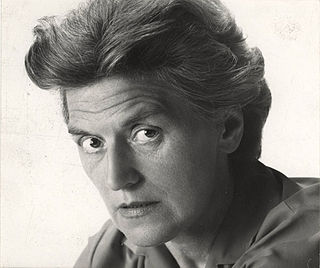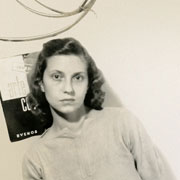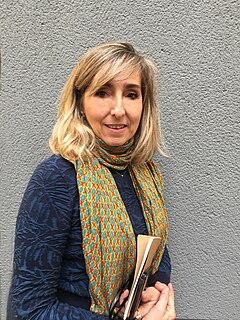
Eduardo Montes-Bradley is an Argentinian–American documentary filmmaker. Since 2008 he presides over Heritage Film Project. His most recent documentary is Daniel Chester French: American Sculptor about Daniel Chester French, the artist who designed the seated Abraham Lincoln at the Lincoln Memorial produced with the support of the National Trust For Historic Preservation and Chesterwood.

Liliana Porter is a contemporary artist working in a wide variety of media, including photography, printmaking, painting, drawing, installation, video, theater, and public art.

Grete Stern was a German-Argentine photographer. With her husband Horacio Coppola, she helped modernize the visual arts in Argentina, and presented the first exhibition of modern photographic art in Buenos Aires, in 1935.

Annemarie Heinrich was a German-born naturalized Argentine photographer, who specialized in portraits and nude photographs. Heinrich is considered one of Argentina's most important photographers.

Gaby Herbstein is a visual artist and Argentine photographer. Her work has been published in magazines, books, blogs and exhibitions across Latin America, the US, Russia, China and Japan.

Lidia "Lidy" Elena Prati (1921–2008) was an Argentine painter who was known for her abstract, geometric paintings. Her artwork called into question representational art and was influential in defining the concrete art movement in Latin America. Prati contributed to the publication of Arturo magazine and during the 1940s, was one of the founding members of the Asociación Arte Concreto-Invención (AACI) art movement along with Enio Iommi and Tomás Maldonado. While she is primarily known for her concrete art paintings, Prati also worked in graphic and layout design and worked with textiles and jewelry.
Silvia Kolbowski is an Argentine-born American artist whose work focuses on cultural and political issues. Kolbowski works primarily with video and installation formats, as well as photography, often using historical figures and events to analyze cultural phenomena and power imbalances.
Delia Cugat is an Argentinian artist who has lived and worked in Paris for most of her professional career, with her partner Sergio Camoreale, also a well-known Argentinian artist). Cugat is one of the founding members of the graphic art group Grabas. Cugat's work encompasses the solitary everyday world of Edward Hopper, the pictorial reflection of Balthus, and the Cubist idea of composition of Jacques Villon. She has her own world of meanings and has established herself as belonging to that of the Latin American greats.
Melissa Ann Pinney is an American photographer best known for her closely observed studies of the social lives and emerging identities of American girls and women. Pinney's photographs have won the photographer numerous fellowships and awards, including Guggenheim and NEA Fellowships, and found their way into the collections of the major museums in the US and abroad.

Martha Boto was an Argentinian artist. Boto was born in Buenos Aires, Argentina, and was co-founder of the Group of Non-Figurative Artists of Argentina. She is considered to be a pioneer of kinetic and programmed art.
Isa Soares is a Brazilian-born Argentine dancer and activist involved in creating awareness of the African traditions of Argentina and fighting racism against Afro-Argentine peoples. She was one of the pioneers in developing African dance interpretation and instruction in Argentina.
Silvia Levenson is a contemporary artist and political activist working in glass. Originally a graphic artist in her native Argentina whose work, both artistic and political, was in direct conflict with the dictatorship of Jorge Rafael Videla, she found herself and her young family immigrating to Italy in 1980. Glass soon became the new medium in which she could best express her feelings of exile, oppression and personal tragedy.

Julia Wernicke was a painter and engraver from Argentina. She is known as the first animalist painter from Argentina, and was unique at the time in incorporating exotic animals into her paintings. She paved the way for female artists in Argentina through many firsts, especially within the discipline of engraving. Wernicke was one of the first women to have an individual exhibition of works in Buenos Aires, in 1897; and the first person to have an individual exhibition of engraved etchings in Argentina, in 1909.

Raquel Rabinovich is an Argentinian-American artist. She is known for her monochromatic paintings and drawings as well as for her large-scale glass sculpture environments and site-specific installations along the shores of the Hudson River. She is included in the Oral History Program of the Smithsonian Institution Archives of American Art. Her work is included in numerous museum collections, including the Whitney Museum of American Art, the Metropolitan Museum of Art and the Smithsonian American Art Museum.

Andrea Graciela Giunta is an Argentine art historian, professor, researcher, and curator.

María Ortega Gálvez is a Spanish artist specializing in painting, engraving, photography and textiles. She is director of the international association World Textile Art (WTA) and director of WTA's VIII International Biennial of Contemporary Textile Art, held in Madrid, Spain in 2019.
Silvia Torras (1936–1970) was a Catalan informalist painter. Torras became a notable artist in the Argentine informalism movement and showed her work in several major exhibits during the short period she painted.

Fabiana Barreda is an Argentine photographer, performer, installationist and multimedia artist. Her work specializes in the body, desire and politics of gender. She has participated in national and international exhibitions, being the most important ones in places such as Museum of Modern Art, New York University (USA), International Architecture Biennale Rotterdam (Netherlands), Telefonica Foundation of Madrid (Spain) and Museum of Monterrey - MACO (Mexico).

Silvia Rivas is an Argentine visual artist known for her multi-channel video installations. In Latin America she is considered a precursor in the area of expanded video. Her work is characterized by the crossing of materialities and technologies in which she uses both electronic devices and ancestral techniques. Her production is organized in thematic series of video installations, drawings, photographs or objects. Interested in revealing the metaphorical power of different materialities, she uses the electronic medium and the moving image to record stillness, the imminent and the subjective perception of time.

Silvia Gabriela Lospennato is an Argentine political scientist and politician, currently serving as National Deputy elected in Buenos Aires Province since 2015. She is a member of Republican Proposal (PRO).
















